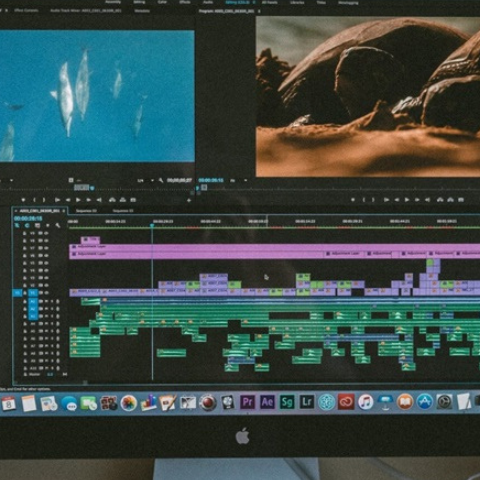
Tips To Choose The Best Online Film Director Course
December 1, 2023
How To find The Right Staff Augmentation Service Provider?
December 28, 2023

Film editing is often referred to as the “invisible art” in the world of cinema. It plays a pivotal role in shaping the narrative, pacing, and emotional impact of a film.
While it may go unnoticed by the audience when done seamlessly, skilled film editing is essential for creating a cohesive and engaging cinematic experience.
In this blog, we will explore the fundamentals of film editing, shedding light on the key techniques and principles that make it a crucial aspect of filmmaking. We also talk about how attending a film editing school online can help you advance your career.
Fundamentals Of Film Editing:
- Understanding Continuity Editing
Continuity editing is the cornerstone of film editing. It is a set of principles and techniques aimed at maintaining a smooth and logical flow of action within a scene or between different scenes.
The 180-degree rule, for example, ensures that the spatial relationships between characters remain consistent, preventing disorientation for the audience. Mastering continuity editing is essential for creating a seamless and immersive viewing experience.
- Mastering The Cut
The cut is the basic building block of film editing. It’s the point where one shot ends, and another begins. Understanding the various types of cuts, such as the straight cut, match cut, and jump cut, is crucial for creating visual interest and maintaining coherence in storytelling.
The rhythm and pacing of a film heavily rely on the editor’s ability to make precise and impactful cuts.
- The Importance Of Timing
Timing is everything in film editing. It involves knowing when to make a cut, how long a shot should last, and when to introduce new elements. Effective timing can enhance the emotional impact of a scene, create tension, or even deliver comedic timing. Editors must have a keen sense of rhythm and pacing to keep the audience engaged and invested in the story.
- Utilising Transitions
Transitions help connect different shots and scenes smoothly. Common transitions include cuts, fades, dissolves, wipes, and more. Each transition serves a specific purpose, whether it’s signaling a change in time, location, or emotion.
Choosing the right transition at the right moment is an art in itself, and a skilled editor can use transitions to guide the audience through the narrative seamlessly.
- Creating Emotional Impact
Film editing is a powerful tool for evoking emotions. The juxtaposition of shots, the duration of each frame, and the overall pacing contribute to the emotional resonance of a scene.
Through careful editing, an editor can amplify the impact of a character’s expression, heighten suspense, or bring depth to a dramatic moment. Understanding the emotional language of editing is essential for connecting with the audience on a visceral level.
- Collaborating With Sound Design
Sound design is a critical element in film editing that often goes hand-in-hand with the visual components. The combination of visuals and sound can create a sensory experience that resonates with the audience.
If you pursue a film editing course online, there will be emphasis on editors collaborating closely with sound designers to ensure that the audio enhances the storytelling and contributes to the overall atmosphere of the film.
- Embracing Technology
Advancements in technology have transformed the landscape of film editing. Digital editing software provides editors with unprecedented control and flexibility. A film editing school online delves into the understanding of how to use editing software efficiently is essential for modern filmmakers.
Additionally, knowledge of color grading, visual effects, and other post-production techniques allows editors to enhance the visual appeal of the final product.
Start Your Film Editing Career With Whistling Woods International’s Virtual Academy
Film editing is a dynamic and intricate process that requires both technical skill and artistic sensibility along with kn. By mastering the fundamentals of film editing, perfecting the art of the cut, understanding the importance of timing, utilising transitions effectively, creating emotional impact, collaborating with sound design, and embracing technology, editors can elevate the quality of a film and captivate audiences.
Embark on your film editing journey with the Virtual Academy offered by Whistling Woods International a film editing school online. They offer an Advanced Certificate Program In Filmmaking.
Their program is designed to provide a comprehensive understanding of film editing, featuring multiple testing protocols to assess and enhance your skills.
More details about their film editing course:
- Duration: 1-year program
- Learning Formats: 60+ hours of Video lectures, Live sessions, and Offline workshops
- Faculty: Industry experts from Whistling Woods International
- Library Access: Extensive industry interactions and Q&A sessions
- Specialisation: Workshops at Whistling Woods Campus
- Certification: Advanced Certificate upon completion
- Virtual Learning: Flexible, accessible from anywhere
Whether you’re a budding film editor or someone eager to delve into the world of filmmaking, Whistling Woods International’s Virtual Academy provides a film editing course for you to cultivate your skills and set the stage for a fulfilling career in the industry.



